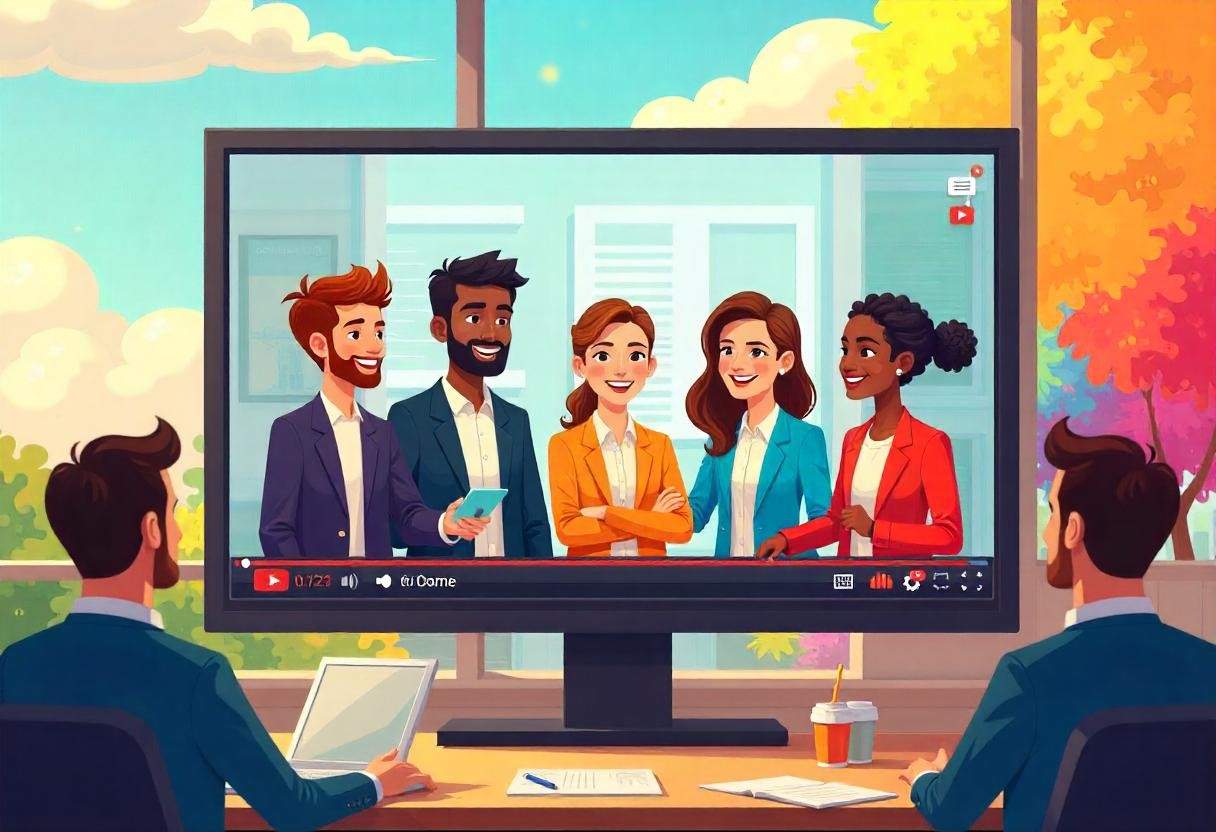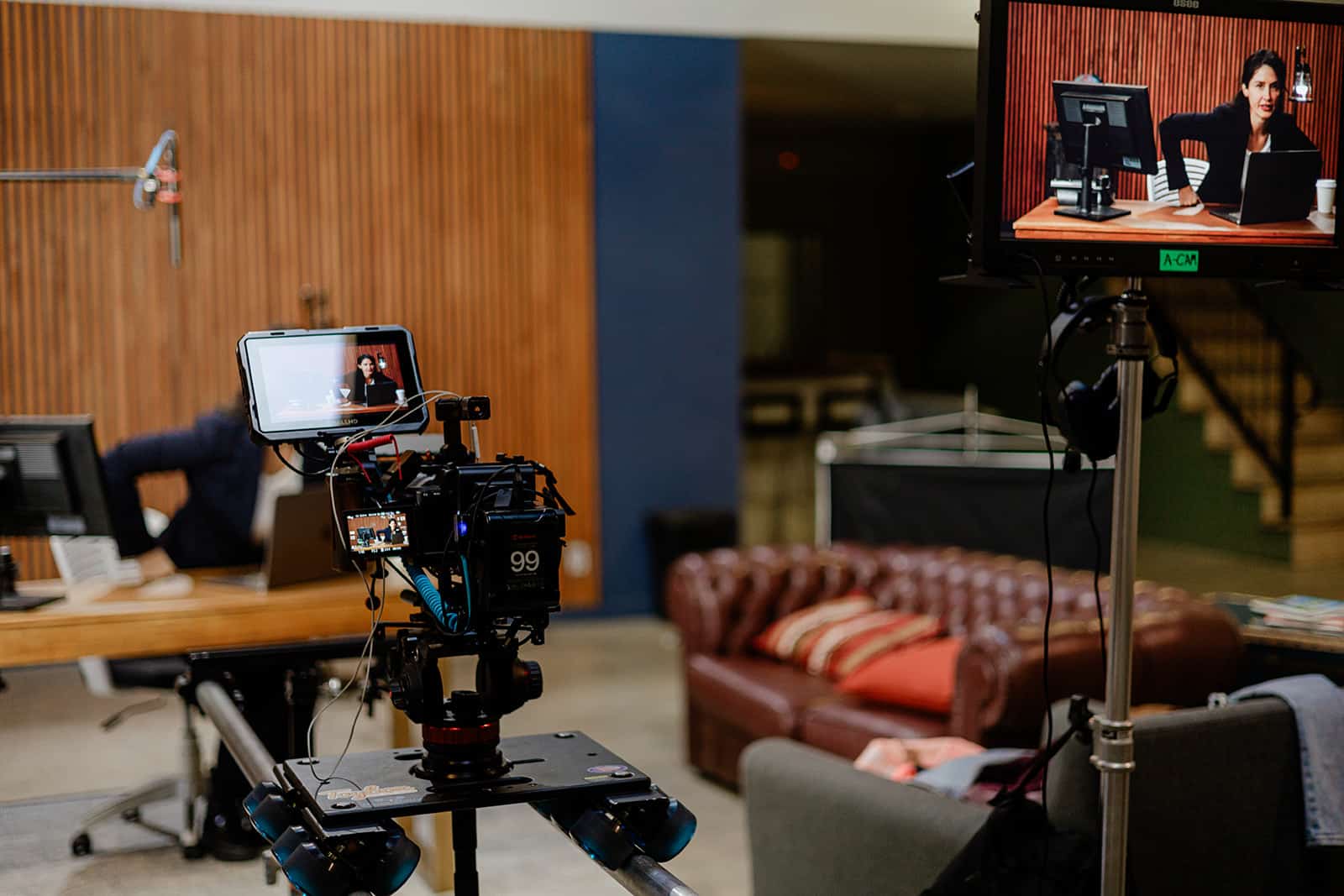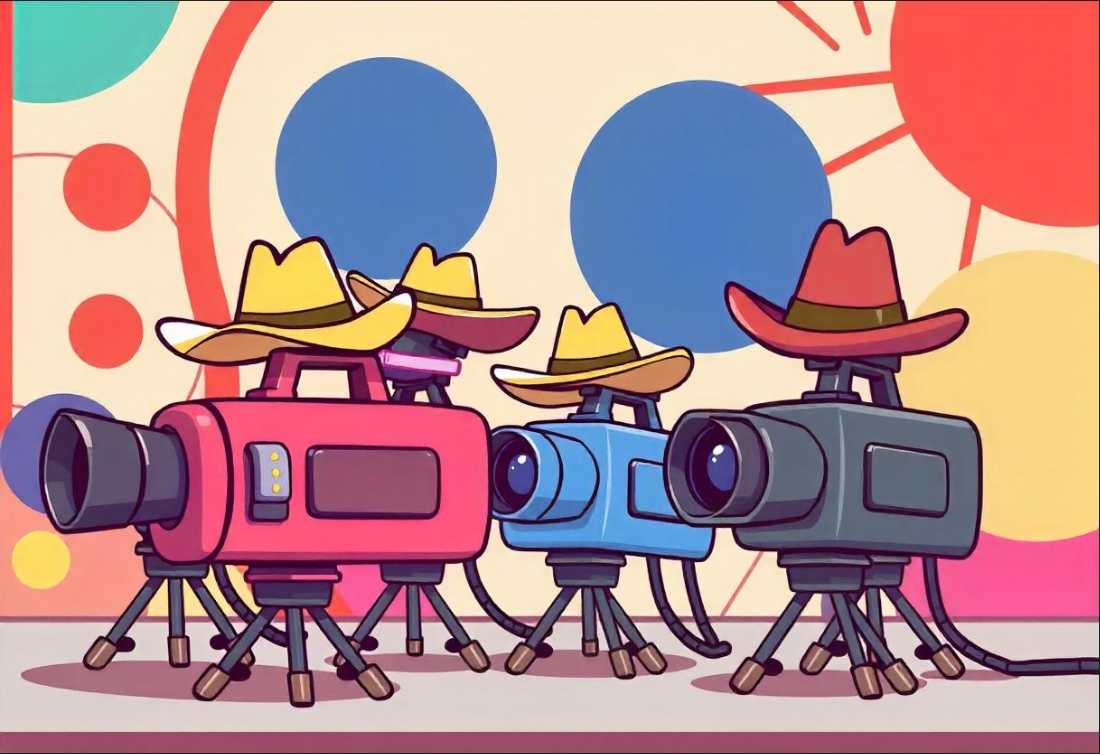Company culture, now in HD form.
The Office once made Michael Scott run away from responsibilities, and he felt good. But you can prevent your employees from tuning out.
How, you ask?
Internal communication videos. These are winning clips that share company updates, culture, training, or milestones.
Such content has multiple magnets to attract employee’ views and hook their minds. Visuals, real human, interactive elements, and clarity.
For this, 57% of workers find video messages from the CEO more engaging. (Source: Promoshin)
Want to make one? Here’s how-
- Plan- Keep it short and simple
- Film- Use your phone, good lighting
- Edit- Cut the fluff, add subtitles
- Share- Post where employees are active
Ready to ditch dry emails and create videos your team actually watches?
Internal Communications Video Production
In-house messages, starring your team.
Internal communications video production means creating visual content made just for employees. You use them inside your company to talk to your own people.
Not customers. Not the public. Only your team. This is like office messaging, but way more fun and easier to understand.
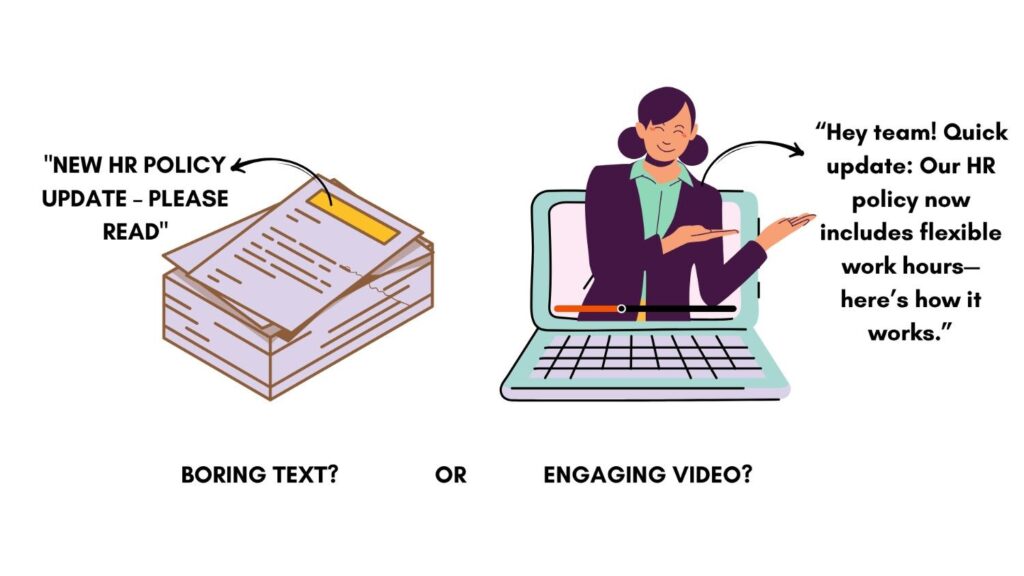
Such content involves-
- Sharing big or small news
- Updating staff
- Training or educating new hires
- Announcing changes
- Explaining stuff or
- Just keeping teams connected
That helps ensure your teams stay on the same page.
These videos replace boring emails and long meetings.
Example? A CEO update on company goals. A how-to guide for new SaaS. Or a fun recap of the annual retreat.
Types of Internal Communication Videos
- Company updates
- Training and onboarding
- Employee recognition
- Event recaps
- Crisis or urgent messages
Benefits Of Using Video For Internal Communication
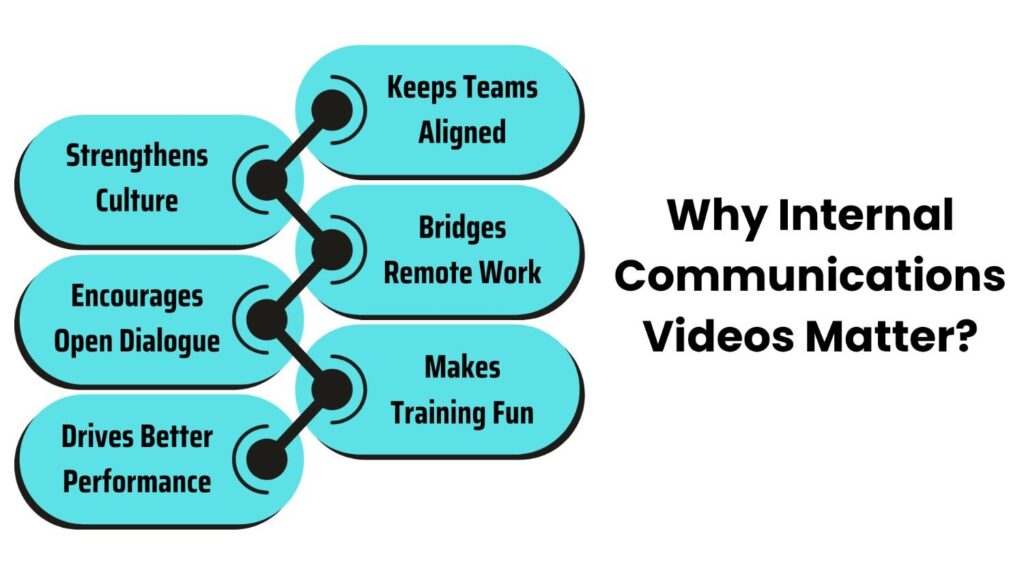
Keeps Everyone Informed
Who likes being out of the loop? None.
A video helps ensure corporate updates don’t get lost in inboxes. Reason- videos are easier to see and remember.
The visuals, real people, voices, sound, and graphics- all these help people remember information. Stats from a Forbes article mention,
“Viewers hold 95% of a video’s message, compared to just 10% when it’s from text.” So, videos can be a great tool.
Moreover, when everyone sees the same thing, misunderstandings drop. People stay aligned.
Let’s say there’s a policy change. Send a 2-minute explainer video. People watch it on their break. Boom! Info shared.
Even better? Your employees are 75% more likely to watch a video than read an email. (Source: HRCloud)
Boosts Trust and Company Culture
Vibe matters, so does trust.
A healthy company culture means:
- Strong teamwork
- Motivated people and
- A positive work environment
All these start with trust and connection. Videos help here.
Share wins, success stories, or even simple thank-yous through the video. It shows there are real people behind the content. Your team sees faces. They hear voices.
That builds trust between employees and employers.
For example:
A friendly video from leaders feels warm and real. Better than a cold email. This feels human.
Research by Paul Zak highlights that-
Employees at high-trust companies are 76% more engaged and 50% more productive.
That’s big.
Video here makes people feel seen and valued. That builds trust and improves strong cultures.
Connects Remote/Hybrid Teams
Distance shouldn’t kill connection.
When your team works from different spots- cities or even countries, it’s easy to feel disconnected. A Zoom call helps. But it’s not always enough.
People stay busy. Time zones clash. On top of that, many remote workers silently struggle with exclusion.
New research reveals that,
“Remote employees mostly feel left out and ganged up on than their on-site colleagues.”
Internal video can be a huge fix.
Just record a quick update or message. Share it with the entire hybrid team. No need for everyone to join live. It’s easy and convenient.
Plus, such videos make teams (online and offline) feel included. In short, they help bridge the gap.
Simplifies and Enriches Training
Reading a 20-page training manual? Snooze.
Videos show real-life examples. They make information easier to understand. Instead of just reading, employees can see how things work step-by-step.
This saves time and keeps them interested. How?
Training videos typically explain policies, software, or safety rules in plain language.
They include creative graphics, animations, demonstrations, and quizzes. Some even have fun characters or humor.
All these work to hook workers and employees.
For this, around 70% of employees prefer learning new skills from videos over written documents.
So, if you want training to be easier, more effective, and even fun, videos are incredible tools.
No more boring handbooks. Just quick, lively lessons that stick.
Promotes Transparency and Feedback
No more guessing games.
When leaders talk on camera, they can show tone, expression, and even empathy. That’s hard to do in text. It encourages employees to speak up, too.
Internal video platforms often have comment features. So when someone posts an update, others can react, ask questions, or share thoughts.
This creates an open, two-way space for conversation.
Transparency plays a big role in the corporate world. 86% of Americans say it’s a top priority for businesses. (Source: Sprout Social).
Internal communication videos help ensure that. They show real, unfiltered communication. Leaders can address concerns directly, and employees feel heard.
When there’s open communication and clarity, it strengthens the entire company.
Fuels Performance and Results
Progress slowing down? Not anymore.
Confused employees can’t perform well. That’s where internal videos help. They explain goals, show how-tos, and keep teams aligned.
When teams understand what’s expected, they act with confidence. That builds focus.
And focused people get things done.
Even research says the same thing. One paper mentions that “using short videos in employee development makes a big impact. It boosts productivity, efficiency, and job satisfaction. Workers feel more engaged and ready to perform.”
This means faster project completion, fewer mistakes, and stronger teamwork. All these lead to better results for the company. Your business can witness higher sales, improved customer service, and overall growth.
Want to turn these benefits into real results? Partner with LocalEyes to create videos your employees won’t ignore.
Types of Internal Communication Videos
- Company updates
- Training and onboarding
- Employee recognition
- Event recaps
- Crisis or urgent messages
Planning Your Internal Communications Video
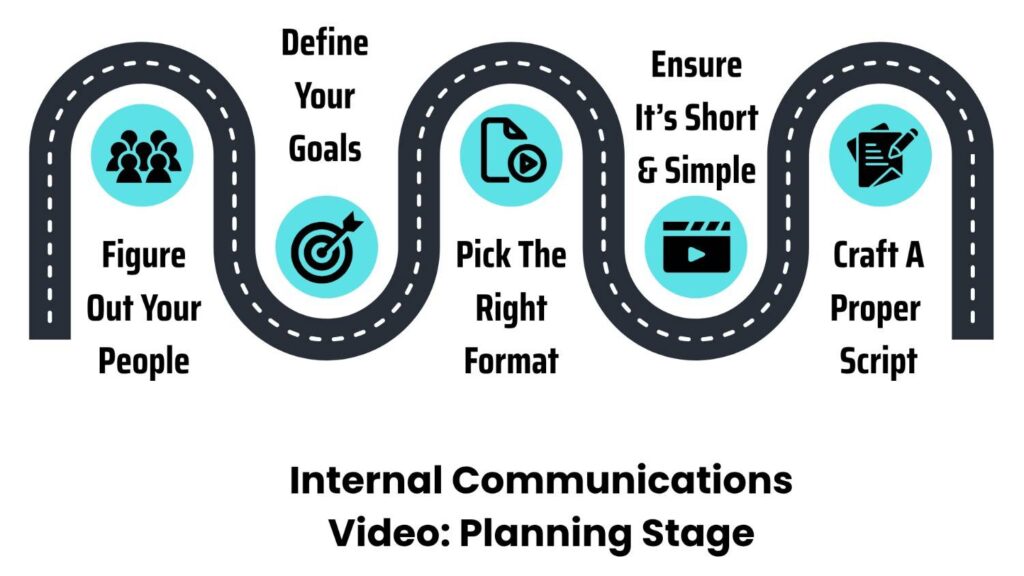
Know Your People
Think about who will watch your video.
Are they managers, new hires, potential candidates, or the whole team? Understanding your people helps you use the right words and tone.
For example
- A video for new employees should explain things simply.
- Meanwhile, a message for managers can be more detailed.
Set A Clear Goal
Decide what you want the video to do. Is it to
- Share news?
- Teach a skill? or
- Boost motivation?
A clear goal keeps your video focused. If you don’t know what you want, your message can get confusing. And the result will be negative.
Choose The Right Format
Internal comms videos come in many styles. There’s
- Animation
- Talking heads
- Interviews or
- Screen recordings
Pick a format that fits your message and viewers.
For instance
- An interview works well for sharing personal stories.
- An animated explainer is good for explaining complex corporate ideas.
Keep It Short and Simple
People are busy, so keep your video short.
Ideally under 3 minutes. Why? Because-
The average length of a video someone watches online is 2.7 minutes. [Source: The New York Times]
Use simple language and visuals. Focus on one main idea. This helps viewers understand and remember your message.
Write A Script or Outline
Before playing the SHOOT button, design a script.
Write what you want to say. Include-
- Scenes
- Dialogue
- Music and sound effects
A script or outline keeps you organized and ensures you don’t forget key points. It also helps keep the video smooth and clear.
Producing Your Internal Communications Video
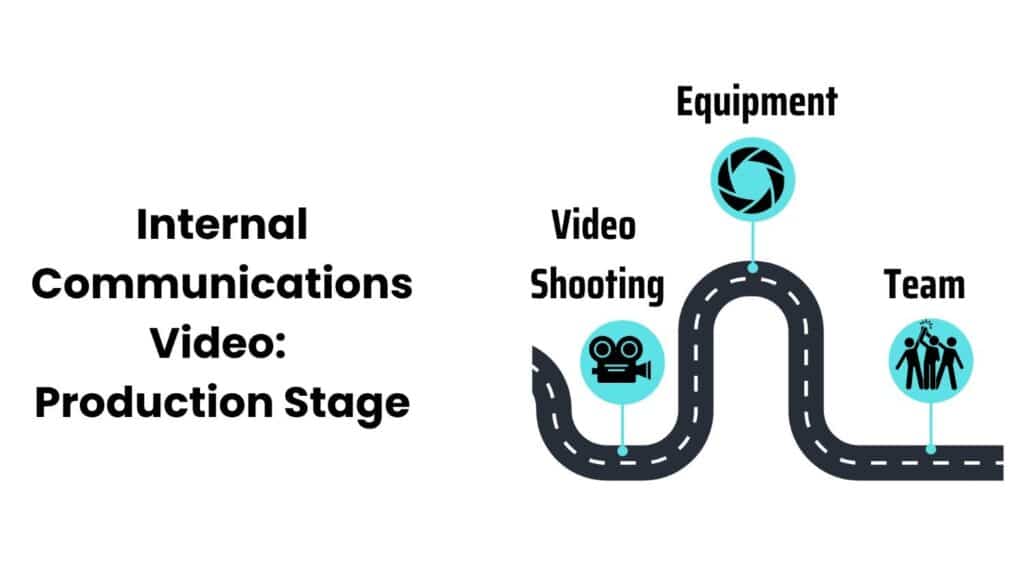
Equipment Needs
Use what you have.
You don’t need Hollywood equipment for Internal Communications Video Production.
Try a simple camera that records in HD. Most smartphones today can do the job.
Get a tripod. This helps you avoid shaky footage.
Use a microphone for clear sound. Because laptop mics or built-in audio often sound distant or echoey.
In case it’s outdoor video shooting, natural light is the best. Golden hour is the perfect timing. It’s because noon time can create deep shadows and distort colors.
If filming indoors, use soft lights or shoot near windows during the day. Good lighting makes people look more natural and engaged on screen.
Avoid poor sound and bad lighting. Both can make even great content hard to watch.
Team
Small crew? That’s fine in the world of Internal Communications Video Production.
You can craft such content with your own team.
One person can handle the camera. Another can guide the speaker or help set up.
If you’re recording leadership messages or training, get someone who can ensure everything stays on topic.
Also, have someone check the footage as it’s recorded. It saves time later.
If you don’t have a good team, consider a video production company for the job. They’ll handle all the work from planning to post-production, leaving you stress-free.
They can charge $1,000 to $16,000+ for a 60-second internal comms video.
The price varies based on-
- Length
- Type
- Complexity
- Scope
- And other things
Filming Tips
- Keep the background clean. No messy desks or distracting posters.
- Ask the speaker to talk slowly and clearly.
- Break things into short takes so no one gets tired.
- Use simple angles: straight on or slightly from the side.
- Don’t overthink it. The goal is to connect, not impress.
- Keep it human, clear, and friendly. That’s what makes people pay attention.
Editing Your Internal Communications Video
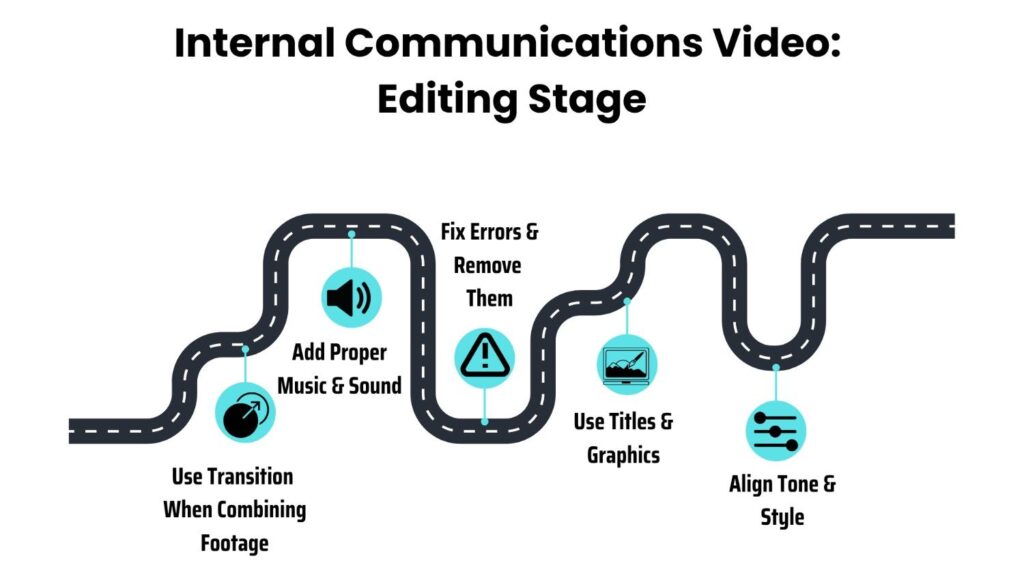
Combine With Transition
Put the clips together in the right order.
Use simple transitions like
- A quick fade or
- Slide to move from one part to the next
This makes the video feel smooth and natural.
Hard cuts with no flow can feel jumpy or confusing.
Add Sound Effects and Music
Light background music helps keep the energy up.
Just keep it soft so it doesn’t distract from the voice. Use sound effects only when they add something-
- Like a ding when showing a result.
Don’t overload it. The goal is to make it feel polished. But not noisy.
Fix Errors
Cut out anything unnecessary. This can be-
- Long pauses
- Stumbles or
- Off-topic moments
All these are distractions and can make viewers lose interest.
If someone repeats a sentence or says “um” too much, remove that. It keeps the video sharp and easier to follow.
Then again, ensure the video flows smoothly. And that there’s a human touch. Too many cuts can make the video feel glitchy.
So, focus on balancing that.
Check the audio. If there’s a weird background noise, try to reduce it.
Using Titles and Graphics Cards
Add titles to show who’s speaking or what topic’s coming up.
Use animated graphics and infographics to highlight
- A tip
- Stat or
- Message
It makes information interesting and helps people remember things better.
Align Tone and Style
Keep everything consistent.
- If it’s a casual video, avoid fancy effects.
- If it’s more formal, keep colors and text clean.
Match the style to your company’s vibe. Use bright colors, dynamic visuals, and other elements that can attract people.
Sharing Your Internal Communications Video
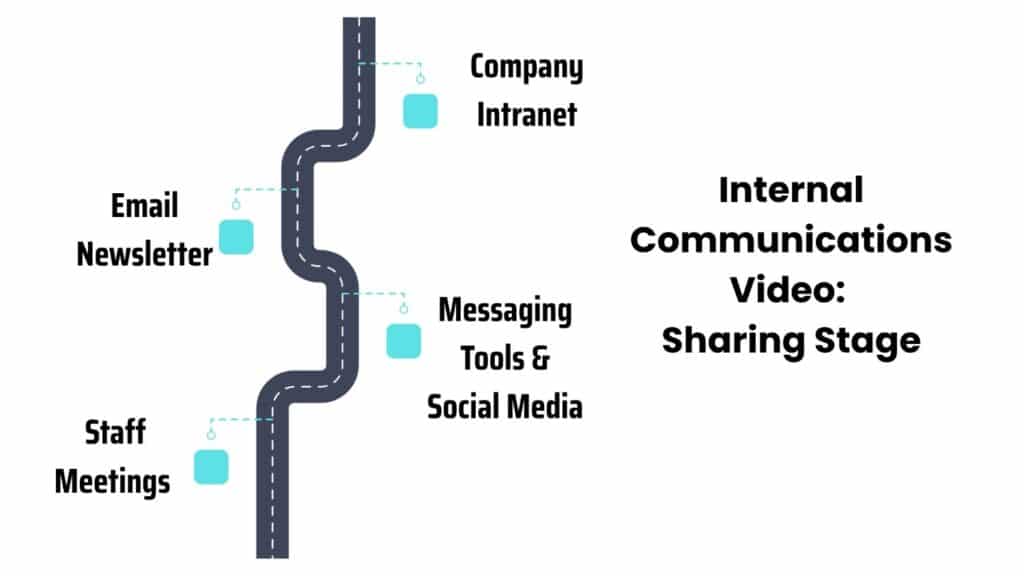
Company Intranet
Upload the video to your company’s internal portal.
That way, your team members can easily find and watch the content later. It also keeps everything in one place.
Add a short description. This will help let people know what it’s about before clicking.
Email Newsletter
Add the video to your next internal newsletter.
Write a quick line about why it matters and how it helps. Give a nice, catchy headline so people want to click.
Most employees check emails during breaks. So, this is a good way to reach them.
Use a thumbnail or a “watch now” CTA button to catch attention.
Messaging Tools and Social Media
Drop the video in team chats and apps. It can be
- Slack
- Google Chat or
- Microsoft Teams
These tools are where most of your workers already chat or share updates.
Post it in relevant channels or groups. If your teams are connected on Facebook and LinkedIn, create a group. Share there.
Keep the message short and friendly. You can even tag someone if the video is meant for their team.
Staff Meetings and Town Halls
Play the video during team meetings or monthly town halls. It’s a great way to keep everyone aligned.
You can pause and talk through parts if needed.
Plus, it gives a human feel when shared live with a group. Your employees would love to engage when they see it together.
7 Key Metrics You Must Track
1. View Count
How many people hit play?
2. Click-Through Rate (CTR)
If your video links to something, who clicked?
3. Watch Time
How long did they stay?
4. Engagement Rate
Likes, comments, reactions.
5. Completion Rate
Who watched the whole thing?
6. Social Shares
Who passed it on to others?
7. Impressions
How many times has it appeared on someone’s screen?
Common Mistakes And Solutions
| Mistake | What Goes Wrong | Fix |
| Too long or too complex content. | Employees don’t finish watching. | Keep it under 3 mins. Focus on one clear message. |
| Too much jargon or corporate speak. | No one connects. | Use simple words and plain language. |
| No planning or skipped edits. | The video feels messy or boring. | Always plan. Even 5 minutes of prep helps. |
| No subtitles | Hard for the hearing-impaired or in loud offices. | Add captions. Most tools do it auto. |
| Ignoring employee feedback. | People feel unheard. Get ignored. | Ask for input. Run short polls or comments after. |
Frequently Asked Questions (FAQs): Internal Communications Video Production
What are examples of internal communications?
Team emails, company newsletters, training videos, leadership messages, chat updates, HR announcements, feedback surveys, and staff meetings. All these are primary examples of internal communications.
What are the 7 steps to create an internal communication plan?
Set goals, know your people, choose channels, create videos, assign roles, set a timeline, and track results. That’s the basic way of creating an internal communication plan.
What are the 8 types of internal communication?
Leadership communication, team communication, peer-to-peer, cultural messages, feedback sharing, updates, training, and crisis communication.
What is video in communication?
It’s using video to share messages clearly, but they’re more engaging and fun. For example, updates, training, or announcements.
Make The Internal Communication Be Fun With LocalEyes!
Internal videos shouldn’t feel like a chore. With the right strategy, and the right partner, you can turn every message into a moment.
Contact LocalEyes today to elevate your company’s internal voice.

